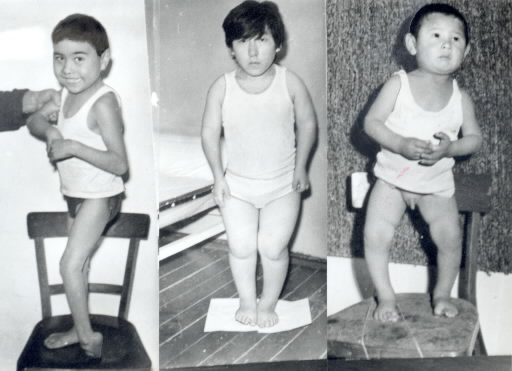5. A High Incidence of Deformities
Jan. 18, 2013
Chapter 2: Soviet Union
Part 1: The Largest Nuclear Test Site in the Nation
Part 1: The Largest Nuclear Test Site in the Nation
It is extremely likely that the fallout from over forty years of nuclear testing in the Semipalatinsk area has caused serious genetic defects. Gricia Gadikbyeva, a pediatrician who works in Semipalatinsk, showed us a long strip of photos.
"This child is seven years old. Her left leg has been twisted since she was born, and she is a bit of a slow learner.
"This girl is actually thirteen, but her weight is only that of a seven- or eight-year-old.
"This three-year-old boy's legs, as well as his toes, are bent.
"A nineteen-year-old youth in bed with terrible cramps in his legs.
"This boy has abnormally short toes..."
The list went on. "All these children have one thing in common," Dr. Gadikbyeva said. "Their parents either used to live near the test site or still live there now. So far we have noted this high incidence of deformities around the test site, extending as far as forty-five miles to the east in Znaminka, ninety miles to the southwest in Kaynar, and directly downwind from the site in the village of Karaaul. But we suspect that areas further away have been affected as well."
After the Second World War, the nomadic Kazakh people were gathered into collective farms in accordance with the agricultural policy of the time. "No doubt the tests were a real shock to them. But because the army kept telling them that there was nothing to worry about, they didn't. As far as they were concerned a nuclear test meant the same as an earthquake."
It was not only the Kazakh people who were left in the dark about the harmful effects of the tests. Dr. Gadikbyeva admitted herself that it was a long time before she knew herself what they could do to unborn children. She first became interested in radiation about ten years ago after talking with the parents of one of the handicapped children.
"I went to the head of the provincial health department to get some detailed information about radiation and genetics, but he told me it was better not to go into that subject too deeply. I'm pretty sure he knew what was going on, but he must have been under pressure from Moscow," she said, lowering her eyes.
Such a tight net of security is kept around the test site that even Soviet citizens are not allowed to enter the city of Semipalatinsk. The advice not to go into the subject of radiation-related diseases too deeply was as good as an order.
Owing to the popular movement to close the Semipalatinsk test site, which began in February 1989, Dr. Gadikbyeva is now able to contact other clinics near the test site and exchange information. The fact that she could show us the photographs freely was most certainly the result of relaxation of regulations and the improvement in communications.
"I can't say for certain that all these children's deformities were caused by their parents being exposed to radiation," she said. "But there is a very strong possibility. I just wish we could get our hands on past data."
Dr. Gadikbyeva and other pediatricians like her continue to pursue the truth about these children's deformities, though their task is not made any easier by the almost complete lack of information. One result of their work has been the discovery that the incidence of stillbirths in Semipalatinsk had actually doubled over a twenty-year period: from 6.1 per thousand in 1960 to 12.5 in 1982.
"Surveys carried out purely for the residents' benefit have only just begun. So far you probably couldn't call it a proper survey, but looking at the figures for stillbirths and deformities you can't help but come to the conclusion that radiation has something to do with them."
Forty-one years after the first test, the effects are being felt by a third generation. We asked Dr. Gadikbyeva if this web of radioactive contamination and secrecy could ever be untangled. Her determined reply was, "It's going to be difficult, but we have to do it."








